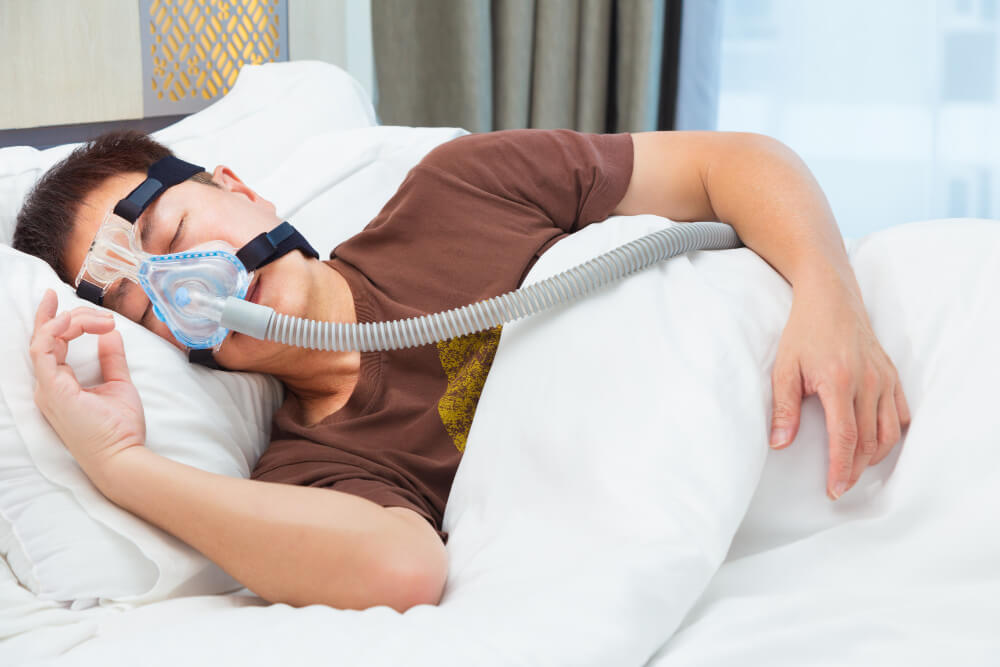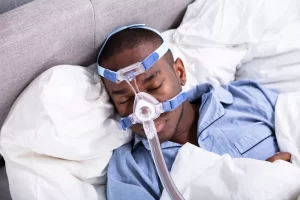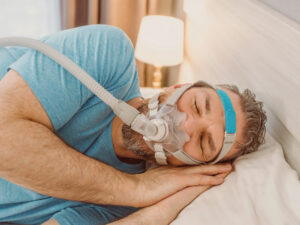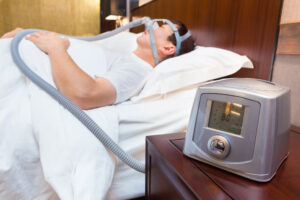CPAP rainout is an increasingly common problem for sleep apnea patients who use Continuous Positive Airway Pressure (CPAP) machines. This uncomfortable and often dangerous phenomenon can disrupt sleep quality and even cause serious health complications.
Fortunately, understanding the causes of CPAP rainout and taking the right preventive steps can help patients get a better night’s rest without suffering any negative consequences.
CPAP machines are vital tools in treating sleep apnea, a condition that affects millions of people around the world. People with obstructive sleep apnea need to have their airways opened while they sleep in order to be able to breathe normally – something that CPAP machines can do very effectively.
Unfortunately, using a CPAP machine also comes with its own set of potential problems, one of which is known as “rainout”.
Rainout occurs when condensation builds up inside the tubing used by the CPAP machine, resulting in droplets of liquid being expelled from the mask connected to it.
This can lead to an uncomfortable feeling as well as potentially harmful consequences like coughing fits or choking sensations which can further disrupt sleep quality or even cause serious health risks if left unchecked.
It is important for all CPAP users to be aware of what causes rainout and how to prevent it in order to make sure they get a good night’s rest without having anything stand in their way.
Definition of CPAP Rainout
CPAP rainout is a common issue experienced by users of continuous positive airway pressure (CPAP) machines. It occurs when the warm, humidified air in the CPAP mask evaporates due to contact with cooler air.
This can cause condensation to build up inside the tubing and mask, leading to rainout and discomfort for the user.
Rainout can be caused by a variety of factors, including temperature, humidity levels in the room or hose, and settings on the CPAP machine itself. To combat it, users can adjust their settings to lower temperatures or increase humidity levels, as well as use heated tubing or a humidifier designed specifically for CPAP machines.
These solutions may help reduce the amount of condensation that forms while using a CPAP machine. Additionally, regularly cleaning the equipment helps prevent rainout from happening in the first place.
Causes Of CPAP Rainout
CPAP rainout occurs when moisture condenses inside the CPAP hose and mask, often leading to water droplets that can be uncomfortable and disruptive to your sleep. This phenomenon is primarily caused by differences in temperature and humidity levels between the air coming from the CPAP machine and the surrounding environment. Here are the key causes of CPAP rainout:
- High Humidity Settings: If the humidifier on your CPAP machine is set too high, it can produce more moisture than the air can hold, leading to condensation.
- Room Temperature: A significant difference between the temperature of the air in the CPAP hose and the room temperature can cause condensation. This is more common in cooler environments where the heated air from the CPAP machine cools down quickly in the hose, turning the moisture into water droplets.
- Insufficient Insulation of the CPAP Hose: Without proper insulation, the warm, moist air inside the hose can cool too quickly, especially in cooler room temperatures, leading to rainout.
- Long Hose Length: A longer hose can increase the risk of rainout because there’s more surface area for the air to cool and condense before it reaches the mask.
- Breathing Pattern: Some individuals breathe more heavily or deeply than others, which can affect the humidity level within the mask and hose, potentially leading to rainout.
- Improperly Adjusted CPAP Settings: CPAP machines with adjustable heat and humidity settings need to be properly balanced. If these settings are not adjusted according to the room environment and individual needs, it can lead to excessive moisture buildup.
- Leaks in the Mask or Hose: Leaks can disrupt the airflow and temperature balance within the CPAP system, contributing to rainout.
To prevent CPAP rainout, you can adjust the humidity settings, use a hose cover, raise the room temperature, use a heated hose, or reposition the CPAP machine so it is lower than your bed. If these adjustments don’t help, consulting with a healthcare provider or a CPAP specialist is advisable for personalized solutions.
Identifying Signs Of CPAP Rainout
Rainout is a common problem for those using a CPAP device. It occurs when condensation forms in the tubing, resulting in a wet and uncomfortable sleeping experience. Knowing how to identify the signs of rainout can help you take measures to prevent it from happening.
The first sign of rainout is increased humidity in the bedroom. This will often be accompanied by a feeling of dampness and moisture in the air. Pay attention to whether your CPAP device’s humidifier is functioning properly; if not, it could be causing rainout.
The second sign is fogging up of your mask while you are using the CPAP machine. If this happens, it almost always indicates that there is too much moisture inside your tubing and mask. You can try reducing the humidity level on your CPAP or inserting a tube liner into your tubing to reduce condensation buildup.
Finally, look for any signs of water droplets inside or outside of your mask or tubing when you wake up in the morning. If you find any, then that confirms that rainout has occurred overnight and that you need to take steps to prevent it from happening again.
Is CPAP Rainout Dangerous
While CPAP rainout can be frustrating and uncomfortable, it’s not inherently dangerous. It primarily causes discomfort and disrupts sleep due to:
- The feeling of water on your face or mask: This can be startling and wake you up, interfering with restful sleep.
- Gurgling noises in the tubing: Condensation buildup can create gurgling sounds that can also disrupt sleep.
- Mask irritation: Constant moisture can irritate the skin around your nose and mouth.
What makes CPAP rainout potentially dangerous:
- Mold and bacteria growth: The warm, humid environment created by condensation can be a breeding ground for mold and bacteria. If not regularly cleaned, this can lead to respiratory infections.
- Decreased CPAP adherence: If rainout makes using your CPAP machine uncomfortable, you may be less likely to use it consistently. This can negatively impact your sleep apnea treatment and potentially lead to serious health complications.
Understanding Humidifier Settings
Now that we have identified the signs of rainout, it’s important to understand how to adjust your humidifier settings to prevent or reduce rainout. There are a few key factors that should be taken into consideration when adjusting your CPAP machine’s humidifier.
The first factor is the temperature of the air coming out of your CPAP machine. If you’re too hot or cold, this can cause condensation in the tube and ultimately result in rainout. To ensure you are comfortable, adjust the temperature setting on your CPAP machine until you find a level that is comfortable for you.
Another factor to consider when adjusting your humidifier settings is the humidity level. It’s important to set the correct humidity level based on the climate and temperature of the room where you sleep. If it is too high, it could lead to rainout; if it is too low, it could cause dryness and discomfort in your airway while sleeping. The optimal humidity setting will depend on these factors as well as individual preferences, so experiment with different levels until you find one that works best for you.
By taking these steps to adjust both the temperature and humidity settings on your CPAP machine, you can help prevent or reduce rainout from occurring while using your CPAP device.
Increasing Tubing Length
When it comes to preventing rainout from CPAP therapy, increasing tubing length is one of the most effective solutions. Longer tubing can give the humidified air more time to reach the user’s mask, reducing the risk of condensation building up in the hose. Tubing lengths range from 6 feet to 10 feet, so users should consider their own therapy needs when selecting a tube. Longer tubes are also beneficial for those who have difficulty reaching their machine or have an obstructive sleep environment.
The second benefit of longer tubes is that they allow for more freedom of movement while sleeping. With shorter tubes, users may find themselves restricted as they move around in bed and tug on their CPAP system. Longer tubes provide additional slack which can help reduce this restriction and make it easier to get comfortable while sleeping.
Finally, longer tubes are often preferred by those who experience difficulty with mask fit due to larger head sizes or facial features. Having extra length can give the user more options for adjusting their mask and finding a comfortable fit that won’t cause skin irritation or leaks. All of these benefits make it easy to see why many CPAP users opt for longer tubing when looking for ways to prevent rainout from occurring during therapy sessions.
Addressing Air Leaks
After discussing ways to increase tubing length in the previous section, now it’s time to focus on addressing air leaks. Air leaks are a common issue for CPAP users and can have a big effect on sleep quality. They occur when air escapes from the mask, allowing unfiltered air to enter the equipment. It is important to address these issues as soon as possible.
The first step in solving an air leak is to make sure that the mask fits correctly and securely. Ensure there is a good seal between the mask and your face. If this does not resolve the issue, try adjusting the straps so they form a tighter fit against your skin. This should help keep any gaps where air could escape closed off.
Another potential cause of air leaks is rainout, which occurs when condensation builds up in your tubing due to cold temperatures outside or humidity inside your bedroom. To prevent rainout, you can raise the temperature of your bedroom slightly or buy a heated humidifier for your CPAP machine, which will help regulate temperatures inside the tubing while you sleep.
These two steps should help ensure that no more unfiltered air enters your device while you’re sleeping and that you get a comfortable night’s rest without any further interruptions from an uncomfortable mask or other issues caused by an air leak.
Reducing Room Temperature
The humidity of the air in your bedroom can be one of the leading causes of CPAP rainout. To minimize this problem, it is important to reduce the room temperature to an optimal level. This means that you should aim for a temperature between 65 and 72 degrees Fahrenheit (18-22 degrees Celsius). You can do this by using a fan or some other type of cooling device.
Another way to reduce the room temperature is to keep windows open at night. This allows cool air from outside to enter your bedroom and help reduce the humidity levels. Additionally, you should avoid running any appliances that produce heat while sleeping with your CPAP machine, as these will increase the temperature of your bedroom.
It is also important to make sure that you are adequately hydrated before going to bed. Drinking plenty of water helps reduce humidity levels in the air and may help prevent CPAP rainout. Additionally, it’s best to avoid heavy meals right before bedtime so that your body doesn’t have to work harder than necessary while you’re trying to sleep.
Use Of Heated Tubing
Now that the room temperature has been reduced, another option to help prevent rainout is to use heated tubing. Heated tubing works by preventing condensation from forming on the tube walls, thus reducing or eliminating rainout altogether. Using heated tubing is particularly useful for those who live in areas with high humidity levels and in cooler temperatures during the night.
Heated tubing can be used with any CPAP machine and usually comes as an accessory that connects directly to the machine. It is made up of two parts: a heating element that warms up the air inside the tube, and an insulation layer that helps keep it warm. This insulation layer also helps reduce noise and vibration coming from the CPAP machine itself.
When using heated tubing, it is important to make sure that it is properly connected to your CPAP machine and set at the right temperature. The recommended setting for most machines is between 35-37 degrees Celsius (95-99 degrees Fahrenheit). Additionally, you should check your mask regularly to make sure there are no air leaks which could cause rainout. With these precautions taken, you should be able to enjoy a comfortable night’s sleep free from rainout issues.
Use Of Water Traps
Water traps are often used to prevent rainout with CPAP machines. Rainout occurs when water droplets form in the CPAP tube due to condensation from humidified air. The water droplets then travel into the mask, where they can cause irritation and reduced comfort. A water trap is a reservoir placed between the machine and the tube which collects any condensation that forms in the tube before it reaches the mask. This prevents rainout and allows for more comfortable use of the machine.
The effectiveness of a water trap depends on its size, as well as how often it is emptied. Generally, a larger volume of water will provide better protection against rainout since it can hold more condensate and last longer between emptying sessions. However, if it is too large, it can become a breeding ground for bacteria and other contaminants which can be harmful to your health. It’s important to find a balance between size and frequency of emptying so that you get optimal protection without sacrificing hygiene.
When using a water trap, make sure that the seal between your tubing and mask is tight enough so that no air leaks out around them. If there are any loose connections or gaps, this might allow some condensate to bypass the trap, leading to rainout even with one installed. Additionally, if you’re using heated humidification with your CPAP machine, make sure not to set it too high as this will increase the chance of rainout occurring even if you have a water trap installed. Taking these extra steps will help ensure that your CPAP therapy remains safe and comfortable for many years to come.
CPAP Mask Options To Prevent Rainout
There are several CPAP mask types to choose from, each with features designed to help prevent rainout. Full-face masks cover the nose and mouth, helping to create an airtight seal. Nasal pillows, meanwhile, fit snugly into the nostrils and provide a stable connection. Specialized masks such as nasal prongs or hybrid masks also provide a seal that may reduce the risk of rainout.
Heated humidifiers can be used with CPAP machines to help ensure that moisture does not escape into the room. Lastly, utilizing a temperature-controlled hose can help keep the air at a consistent temperature and further reduce the risk of condensation buildup.
Various accessories can also be used to minimize rainout. For example, using a chinstrap in conjunction with a full-face mask ensures that no air escapes through the mouth and prevents dryness from occurring in the nose and throat. Likewise, sealing tapes can be applied around the edges of nasal pillow and hybrid masks to improve their fit and prevent air leakage. Finally, special filters can be inserted into tubing systems to help trap excess moisture before it enters your mask.
Whether you’re looking for an effective way to combat rainy weather or simply trying to avoid cold temperatures while sleeping, there are plenty of options available when it comes to choosing the right CPAP mask for you. With careful selection and use of accessories such as chinstraps and filters, you can achieve optimal comfort levels while avoiding pesky problems like rainout.
Benefits Of A Full Face Mask
The full face mask can be a great alternative to prevent rainout. It covers the nose and mouth, providing a more reliable seal than nasal masks. This can reduce the chance of air leakage and the accompanying rainout. Additionally, the full face mask is designed to fit snugly on both the top and bottom of the face, providing extra stability for those who may move around during sleep.
A full face mask also provides more comfort than other types of masks as it reduces pressure points that can cause discomfort. It is also easier to maintain since it requires less cleaning due to its larger surface area. Furthermore, its design eliminates many of the pesky headgear adjustments that come with other masks.
This type of mask offers superior protection against leaks and rainout during sleep apnea therapy, making it an ideal choice for many CPAP users. With greater comfort and stability, as well as less maintenance required, it’s easy to see why a full face mask is a top choice among CPAP users who need to prevent rainout while sleeping.
Tips For Handling Excessive Moisture
Excessive moisture in your CPAP environment can be a major nuisance. Fortunately, there are several things you can do to help manage the problem. Firstly, you can invest in a humidifier designed specifically for CPAP machines; these devices work to keep the air near your mask moist and comfortable throughout the night. Secondly, if you do use a heated humidifier with your machine, try to make sure that it is kept away from any sources of heat or cold air that could cause condensation. Lastly, make sure that you change the water in the humidifier at least once every two days; this will help prevent bacteria growth and reduce the potential for rainout. Taking these steps will ensure that your CPAP experience is as comfortable and safe as possible.
When To See A Doctor
If you continue to experience persistent rainout even after making adjustments, it may be necessary to see a doctor. If the water is entering into your airway, causing CPAP cough or difficulty breathing, seek medical attention immediately.
It’s also important to note that CPAP masks are designed for single user use and should not be shared with others. If you’re experiencing discomfort during sleep, such as headaches or facial sores, these are indicators that it may be time to speak with your doctor about different mask styles and settings.
A physician can help determine if there are any underlying conditions contributing to CPAP rainout and what other treatments may work best for you. They will also be able to provide additional advice on how to prevent rainout from occurring in the future. In addition, a sleep specialist can provide advice on how to adjust the machine settings for maximum comfort and efficacy. By working together with your doctor, you can find a solution that works best for your needs and lifestyle.
Here are several effective ways to prevent condensation from forming in your CPAP mask:
1. Adjust the Humidifier Settings:
- Start by lowering the humidity level: If you haven’t already, try decreasing the humidity setting on your CPAP machine. This can reduce the amount of moisture that gets introduced into the air, minimizing condensation.
- Find the balance between comfort and condensation: Experiment with different settings to find the optimal level that provides comfort without causing rainout.
2. Warm Up Your Bedroom:
- Reduce the temperature difference: Condensation often occurs when warm, humid air from the CPAP machine meets the cooler air in your bedroom. Increasing the room temperature can help minimize this temperature difference.
- Aim for a comfortable and condensation-free environment: Find a temperature that’s comfortable for you to sleep in while also preventing rainout.
3. Use Heated Tubing:
- Maintain consistent air temperature: Heated tubing is designed to keep the air flowing to your mask warm and at a consistent temperature, reducing the likelihood of condensation forming.
- Consider upgrading or adding heated tubing: If your CPAP machine doesn’t have a heated tubing option, you can often purchase it separately or inquire about a machine upgrade.
4. Position Your CPAP Machine Lower Than Your Mask:
- Let gravity work in your favor: Place your CPAP machine on the floor or a lower shelf, ensuring it’s positioned below the level of your mask. This allows any condensation that forms to drain back into the machine rather than collecting in the tubing or mask.
5. Insulate the Tubing:
- Minimize heat loss with a tube cover: If you don’t have heated tubing, you can use a CPAP tube cover, also known as a tube wrap or sleeve. This acts as insulation, helping to maintain the warmth of the air inside the tubing and reducing condensation.
6. Keep Your CPAP Equipment Clean and Dry:
- Prevent bacteria and mold growth: Regularly wash your mask, tubing, and water chamber according to the manufacturer’s instructions. This helps prevent bacteria and mold growth, which can contribute to condensation.
- Ensure thorough drying: After washing, completely dry all components before use.
Additional Tips to Prevent CPAP Rainout
- Explore different mask styles: If condensation persists, consider trying a different type of mask. Nasal pillows or masks that cover less of your face may be less prone to rainout.
- Seek professional guidance: Consult your doctor or CPAP equipment supplier if you continue to experience condensation issues. They can offer further advice and recommendations tailored to your specific needs.
FAQ
How Do I Fix Rainout in My CPAP Machine?
To fix rainout in your CPAP machine, a condition where moisture condenses in the hose and mask, several adjustments can be made. Reducing the humidity level on the CPAP machine can help, as it decreases the moisture content in the air. For those with compatible devices, using a heated hose is beneficial as it keeps the air at a consistent temperature, preventing condensation. Increasing the room temperature can help, ensuring the air in the hose doesn’t cool excessively. Insulating the hose with a fabric cover also aids in maintaining the air temperature.
What Does CPAP Rainout Sound Like?
CPAP rainout creates a mix of sounds like water bubbling through a tube, tiny drops hitting the mask, and air pockets bursting in condensed moisture. It’s a gurgling, spitting, popping, and crackling symphony that can be surprisingly loud and disruptive to sleep. Imagine a gentle bubbling brook mixed with the soft tapping of raindrops and the occasional crackle of a campfire. That’s the closest I can get to describing CPAP rainout in nature’s terms!
What Temperature Should a Tube Be to Avoid Rainout?
The perfect tube temperature for avoiding CPAP rainout depends on personal comfort and room conditions. Cooler rooms and higher humidity tilt the scales towards needing a warmer tube, with most folks finding sweet spots between 78°F and 84°F. Start slightly higher than you think you’ll need and adjust down until rainout fades without leaving you shivering. Heated tubes and warmer bedrooms act as allies, while using a humidifier sparingly and finding a comfy mask position add extra finesse to the moves.
What Happens if Your CPAP Humidity Is Too High?
Too high CPAP humidity can cause rainout (dripping water), skin irritation, mold growth, leaky masks, and even machine damage. Start low, adjust slowly, and don’t hesitate to ask your doctor for help.





[…] Condensation. When the air from your CPAP machine is warmer than the surrounding air, it can condense and form water droplets inside the tubing and mask. This can lead to gurgling sounds and, in some cases, even flooding of the mask. Read more: What Is CPAP Rainout and How Can I Prevent It? […]